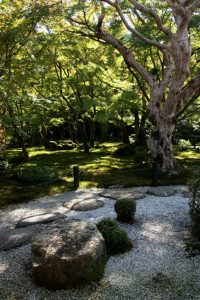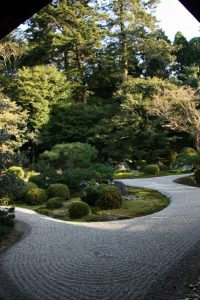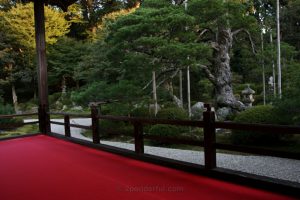Alighting from Ichijoji station on the Eizan line in the North Higashiyama area, I made my way through what a Japanese friend had termed “Kyoto’s bohemian area” on my way to Enkoji. Ichijoji and the Kitashirakawa area have an appealing, faded, past their prime atmosphere as opposed to the dirty, rough around the edges feel in some of Kyoto’s other suburban areas. It’s a good place to wander for an hour before heading to the temples. That is until you reach the pachinko parlour: cute cafes, second hand book shops, ramen and curry stores galore… and then an ugly, prefab monstrosity, noisily ringing out the loss of banknotes.
Well, it does serve one purpose, I suppose: it signals that this is where you cross the road! Keep going straight, leave the noise behind and enter a surprisingly serene world of temple gardens and rice fields – yes, rice fields – a mere 10-minute walk from the station.
Enkoji (圓光寺)
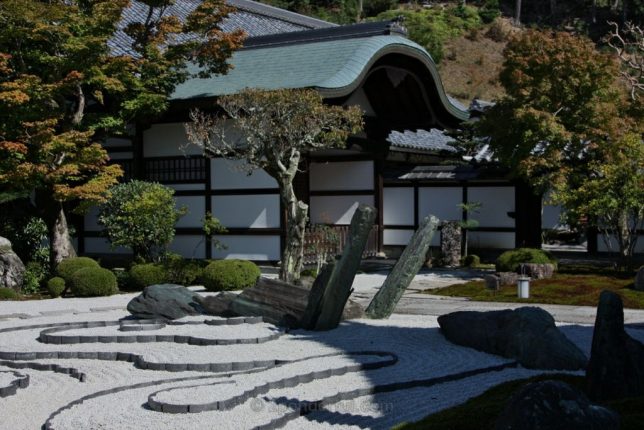
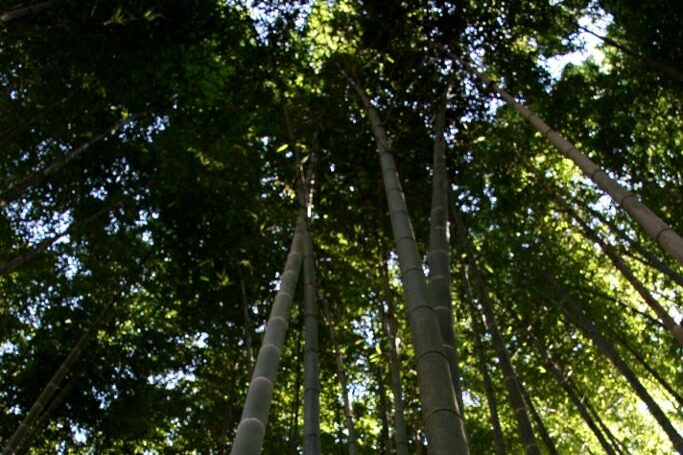
Packed to the brim in November as the garden bursts into scarlet, on an early Saturday afternoon in October, there were only a handful of tourists. The first garden is a modern take on a raked gravel garden: vertical, pieces of slate and a bamboo trellis frame the white stones. To the right is the first viewing platform. This was my favourite. However, this may have been connected to the fact that, for a while, I was the only person perched upon it! Before me, lay the last of the summer green – sunlight filtered through the maple leaves and a solitary stone lantern stood on the moss-covered ground. There is something about moss: it looks so comfortable that I always want to curl up on it and go to sleep. I refrained as I doubt that the monks would have appreciated my moss-appreciating exploits!
My emerald concentration was broken by an expensive looking camera, its holder and his date. He instructed the girl to stand behind the bamboo drapes and peer out in between them. Twenty frames and lots of, “Left a bit, right a bit, forwards, backwards, head up, head down” later, the awkward “ha ha”s between them confirmed that they were a new couple: she was afraid of offending him with an “Enough!” and he knew that he was being a pain, and was torn between getting the perfect shot of the pretty girl and blowing the chance of another date. On to the second viewing platform…
At this point, fifteen or so university age young people doubled the head count. A young woman in a suit was negotiating an upcoming event with one of the priests. He assumed that they would be wearing kimono and she corrected him that they would be in suits. I supposed that they were from Bukkyo – Kyoto’s Buddhist university – and were perhaps planning to hold an event or even a graduation ceremony on the temple grounds. The others soon set about cleaning the buildings, with one poor woman being remonstrated for sweeping up dust on the tatami mats incorrectly!
Following the path in a clockwise direction, a path leads through a small bamboo grove and up a slope to an opening that provides a view over the temple and Kyoto city. Although, do you really want to see the city after relaxing in the garden? I found myself moving to the left and using a tree to block out the view of a large crane!
Access : From Demachiyanagi station, take the Eizen line to Ichijoji (5 minutes, 210 yen) and an easy 15-minute walk west.
Hours : 09:00~17:00 (last entry at 16:30)
Admission : 500 yen.
Shisen-do (詩仙堂)
A 300-metre walk south of Eikando, Shisen-do is entered via an attractive bamboo gate and a flight of stone steps. I was disappointed to be told by the staff that photography is not allowed inside the temple. I didn’t wish to photograph the religious statues but this rule seemed to lead to confusion as to whether photographing the raked sand garden from the tatami room viewing area was OK or not. Funnily enough, it seemed that the Japanese were the ones taking not very surreptitious shots and the foreigners were refraining completely. I found myself turning into the camera guy from Eikando: wanting to take pictures despite knowing that to do so might be detrimental to my immediate future! I also felt a bit annoyed that the postcards for sale didn’t really depict the scene before me.
Mainly, I felt a bit silly for being annoyed when I was supposed to be enjoying the view without being distracted by such trivial things as taking photos. However, the atmosphere in the viewing area seemed to be, “Can I take a photo?”; “Will anyone notice it I take a photo?”; “I’m currently taking an out-of-focus photo with my smart phone cunningly held between my elbow and my waist” and “I’m taking a photo because I don’t care!” A bit weird, really…
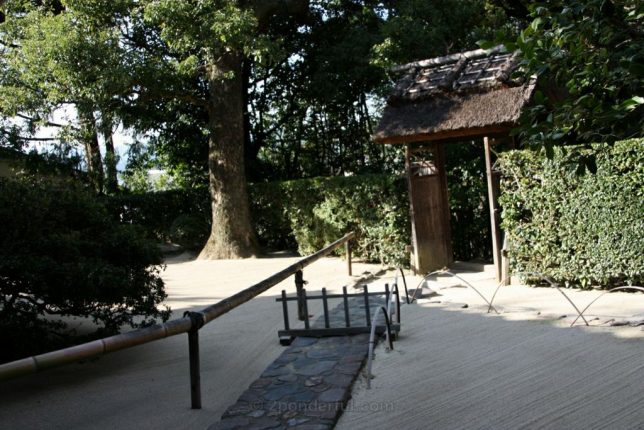
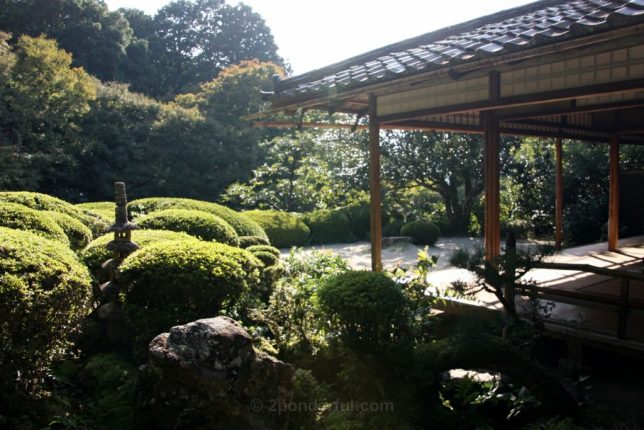
Leaving the to photo or not to photo echo chamber, I was surprised to see a photo of Prince Charles and Princess Diana, who visited the temple in 1986, displayed with pictures commemorating members of Japan’s Royal family doing the same. I know that she was accused of playing it up in front of the cameras, and that it is just one photo, but Diana certainly looks miserable in one of them.
Heading into the garden with the thought, “This will be the only time that I follow in Prince Charles’ footsteps”, I found the source of the annoyingly frequent “Bong! Bong! Bong!” that had really been disturbing my “zen”, and perhaps exempts Charles from responsibility for Diana’s disappointed with her lot in a Japanese temple expression, – a bamboo shishiodoshi. In order to prevent deer and wild boar from entering the garden, a “tap” pours into a bamboo spout that, when full, tips and bashes into a wooden post with a “Bong!” Apparently, there is also some wabi sabi concept at play that foreigners are too unseemly to comprehend. However, to me, it was just an intrusion: “Ah, lovely, more moss…Bong! Oh look! There are some persimmon on that tree…Bong! I wish that bonging would stop…Bong!” The garden was nice, but I didn’t rate it as highly as Enkoji’s. But perhaps I was just there out of season – the azalea only bloom in the spring and there were plenty of maples getting ready for their November curtain call but, to me, there was a lot of sand, plenty of bongs but not enough garden.
Access : A 300-metre walk south of Eikando or a 15-minute walk west of Ichijoji station on the Eizen line.
Hours : 09:00~17:00
Admission : 500 yen (adults); 400 yen (16~18-year-olds); 200 yen (6~15-year-olds)
Manshu-in (曼殊院)
A laminated card in Japlish informs you that photos are not allowed inside the buildings. What? Again! However, as it clearly said – or rather attempted to say – that photos from the viewing area were allowed and, as I had no great desire to take photos of faded sliding doors with barely discernible golden tigers or Mount Fujis, I was not that bothered. However, the “Peacock Room” is certainly worth lingering in as the art is still visible and is quite impressive.
The route to the viewing deck passed photos of more imperial visits and, imagine my surprise, hanging along side portraits of visiting Japanese royalty, a picture of a young David Beckham with two rather star-struck monks! All of the Beckham information, including his full name “David Robert Joseph Beckham” was in Japanese. The sole English word amusingly being “Becks”! I guess that was taken during the 2002 Japan-South Korea world cup. It must have been very quiet here back in 2002!
A pretty, covered wooden walkway led out to the garden view – a lovely sight of raked gravel with two “islands” of foliage including a 400-year-old pine tree that is supposed to look like a crane. H’mmm… My 4pm timing turned out to be perfect: the late afternoon sunlight lit the tops of the trees and the gleaming stone lantern was framed by the silhouettes of leaves. Also, only another six people were there. I was a little naughty and moved one of the signs out of the way – who wants a photo spoiled by the inclusion of dos and don’ts? Temporarily freed from the shackles of rules by a gaijin, a Japanese woman happily joined me in a brief photo-taking frenzy: we carefully danced in and out of each other’s lens and elbow territory in a manner that would have got an ethnographer reaching for her recording device in an instant.
Finally, the pair of us were satiated, she left and only I occupied the red carpet – I was probably still channeling Charles and Diana. I viewed the garden for a happy fifteen minutes before a monk’s obvious clanging and bashing of random objects indicated that it must be 5pm and that I should leave.
I turned right out of the temple and took the long route: the path skirting the edge of the forested hills and followed the canal back to Shugakuin station. The noise was like a blast to the soul.
Access : a 15-minute walk north of Enkoji or west from Shugakuin station on the Eizan line.
Hours : 09:00-17:00
Admission : 600 yen.
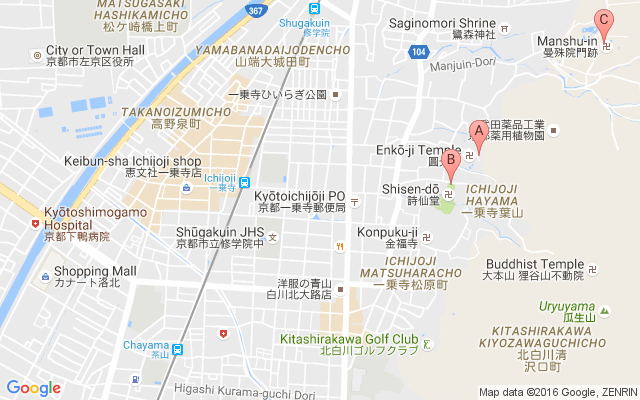
Enko-ji Temple (Map-A)
Shisen-do Temple (Map-B)
Manshu-in Temple (Map-C)
